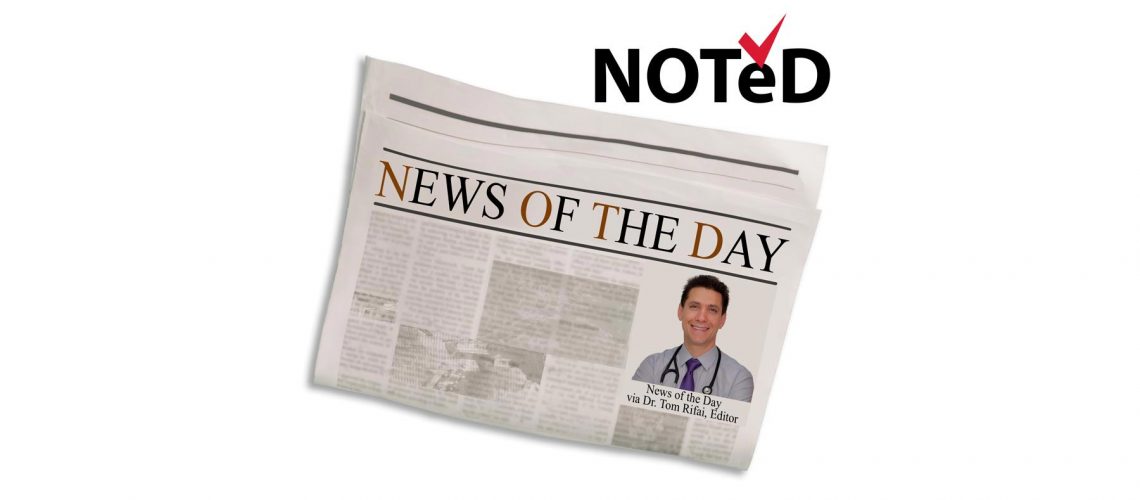Home » NOTeD: Does Cutting Salt Prevent Future Heart Disease?
NOTeD: Does Cutting Salt Prevent Future Heart Disease?

IN TODAY’S MEDICAL NEWS: Cutting Salt Likely to Prevent Future Heart Disease, Even If You’re Not at Risk Now
DID THE MEDIA (largely) GET IT RIGHT? YES!
EDITOR’S COMMENT: Nowhere in the world of nutrition and lifestyle is the public, sadly and unnecessarily, more confused by the pendulum swings of media headlines than regarding salt. Recent studies that led to notions that sodium levels below the current American average could increase the risk of death have been roundly debunked for low quality (e.g., the PURE study). And while there are some naysayers of the importance of cutting sodium from our current high levels (which are, depending on the study in question from 3,300 to over 4000mg/day, with many subsets of people even well above that), authorities ranging from the CDC to the American Heart Association, Dietary Guidelines for Americans, Center for Science in the Public Interest and World Health Organization all agree on the potential to save millions of lives worldwide if sodium levels could be cut to closer to 2000-2300 (in some cases < 1500) mg/day. (For a treatise on WHY we crave salts and other food types, read “How to Eat: Why Isn’t This Clear Already?”)
THE CURRENT STATE OF HEART DISEASE
The fact is that heart attacks kill over 600,000 Americans per year, more than all cancers combined. And the number one risk factor for heart disease is hypertension (elevated blood pressure) with one of (if not the top of all) risk factors for developing hypertension being excess sodium chloride (“salt”) intake. With new blood pressure guidelines from the American Heart Association identifying hypertension starting at a systolic (top number) of 130 or more (versus previous 140), and with the primary therapy for hypertension finally focused on lifestyle change first in the new guidelines, the question of settling the issue of whether sodium reduction from our current average US intake can save lives is of paramount importance.
THE NEW STUDY
This current meta-analysis (a study of many studies combined) was very impressive in the number of studies assessed (133), the type of studies assessed (what many consider “gold standard” – randomized controlled trials) and the measure of sodium intake (24 urine analyses – again, considered gold standard). While most of the studies assessed were short in duration (due to the difficulty of controlling what people eat over long periods), 5 were over 6 months in length.
And the findings were impressive: blood pressure improvements found in all subjects, whether their baseline blood pressure was elevated or not (with particularly robust blood pressure reductions in African Americans and Seniors), high likelihood of blood pressure improving further the longer one maintained a healthy lower sodium intake.
What wasn’t emphasized adequately is that excess sodium intake, independent of its effect on blood pressure, can increase the risk of kidney disease and stroke. The reason quite likely is, at least in part, because excess sodium can damage the inner lining of our arteries via a process called “oxidative stress,” an analogy for which would be how salt can rust our cars.
BOTTOM LINE: Cutting Salt Prevents Future Heart Disease
Excess sodium is believed to be the number one nutritional driver of early cardiometabolic death. And consider that the mass majority of humans survived for hundreds of thousands of years on only natural sodium from unprocessed, plant predominant foods, therefore with natural sodium only (under 1000 mg per day). Now, consider that the occasional “high sodium is good!” outliers are essentially saying that the optimal modern human diet is one that continues to be processed with high amounts of added sodium. Chew on that for a moment…Sound credible? I think not.
Unfortunately at least ~80% of our sodium intake comes from processed foods (see top 10 sources here – caution bread lovers!) at home and when dining out, with salt shakers contributing very little. So, it is critical to learn about where stealth sodium is – especially as it relates to highly processed foods – and minimize their frequency as much as is reasonably possible (i.e., ingest no more than necessary to not wanna shoot the messenger here!) and act accordingly to find alternative “foods that fix” your body rather than “foods that risk” your body. Finding ways to cut back on sodium doesn’t have to be draconian (thin crust pizza, light on the cheese and extra fresh vegetables, anyone?). Seek salt flavoring alternatives that minimize risk (including cooking without sodium and adding just a sprinkle of a 50/50 sodium and potassium salt blend like Morton Lite Salt). And, of course, learning how to be a savvy “no salt added please,” “very light on the sauce/dressing/salty seasoning please” restaurant eater wherever possible. Last, being patient with palate changes, which will occur over several weeks, thankfully is key as you’ll learn to love the more natural flavor of foods with less added sodium.
And, last but not least, no discussion about cutting sodium is adequate without mentioning a concomitant healthy, high intake of the “partial sodium antidote:” potassium! In plain language that means what you’ve heard a thousand times before and I’ve no problem repeating because it bears worth repeating until my last breath: eat your whole fruits and vegetables (yes, including those lovely legumes: beans, lentils and peas) – virtually all of them have healthy doses of blood-pressure-lowering potassium and naturally low (i.e., healthy) amounts of sodium. But you didn’t need me to tell you to eat your fruits, veggies, beans, lentils and peas – your grandma probably did a good job of that already. And grandma’s right! She didn’t really need a study.
Tom Rifai MD, FACP
CEO, Reality Meets Science®

